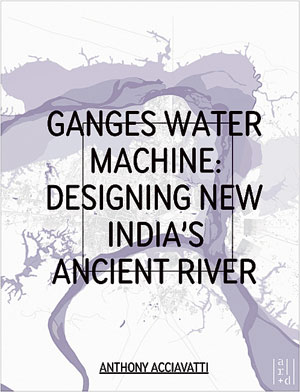Anthony Acciavatti's book Ganges Water Machine: Designing New India's Ancient River is an insanely ambitious piece of field research. Starting in 2005, the New York'based architect and author began crisscrossing the most populous river basin in the world, traveling on foot and by boat, with a camera and hand-held GPS unit, documenting cities, towns, and villages, as well as infrastructure and agriculture. Dismayed to discover that the most recent maps of the fabled river dated back to the 1960s, he set out to chart the route from its source at the Gangotri Glacier in the Himalayas to the city of Patna, taking more than 25,000 photographs, filling 15 sketchbooks, and creating some 350 maps. Originally, Acciavatti set aside a year to do it. The resulting book, produced nine years and many trips to India later, is what he calls a 'dynamic altas,' a dense, historical, visually rich look at the ecological and spiritual heart of India.
Like all great rivers, the Ganges has a deep history of commerce, conflict, culture (including some stunning buildings along its path), colonial and postcolonial politics, and myth-making'of virtually everything, in other words, that humans do when they are drawn to water to form cities and towns. In India, that connection is even more intense: 'Every 12th year, the sleepy university town of Allahabad is transformed into a colossal tent city populated by millions of pilgrims for the Kumbh Mela (literally Pitcher Celebration),' writes Acciavatti. 'And it all seems to happen so fast. The waters of the Ganges and Jamuna slowly recede after the monsoon. A city grid is tattooed into the banks and shoals at the Sangam. Tents and temples pop up in October. Pontoon bridges stretch from one bank of the Ganges to the other and pilgrims begin to arrive in January.'
Despite the river's spiritual hold on India, the Ganges is also, according to Acciavatti, 'one of the most engineered spaces on the planet.' It is, indeed, the huge water machine of the book's title. In the 19th century, the vaunted genius of British engineering took on the winding, flood-prone river, creating a vast network of irrigation canals, aqueducts, bridges, and power stations. This partial taming of the river, which floods annually during the monsoons, was both beneficial (improving access to water and increasing farm output) and overtly political (controlling the river, ultimately, meant you controlled the colony). In the long history of the river that frames much of the book, Acciavatti repeatedly points out the political dynamic underscoring the origins and the continued evolution of the Ganges Water Machine. Now, as always, water is power.
In addition to his own physical survey of the river, the author has done great work as a documentarian, finding dozens of rare maps as well as cultural and historical images from archives all over the world. Combining the two approaches creates an intriguing blend of field research and history lesson, giving the large, lavishly designed book (executed by Julie Ostrow) its contemporary atlas-almanac feel. It's a handsome tome and a striking physical object.
Although the book feels in some ways comprehensive, there's no way it ever could be, given the bottomless depth of the subject matter. And therein lies a problem: Ganges Water Machine manages to be highly visual (the last 80 pages or so contain a series of 'transect' montages, with minimal copy) and extremely dense at the same time. It's not a casual read, and, in places, a full appreciation of the material appears to require some expertise on the part of the reader. The book, in fact, would have greatly benefited from more extensive captioning for many of the images shown. Missing also is a fuller explanation of what climate change might mean for a region so inextricably tied to the seasons.
Still, Acciavatti has produced an impressive work of original research'one that should be of keen interest to the Indian government and the World Bank as they embark on their $1.5 billion cleanup of a murky, mystical river that manages to be both India's heart and its soul.
Martin C. Pedersen is a New Orleans'based writer and editor and the former executive editor of Metropolis magazine.



Post a comment to this article
Report Abusive Comment